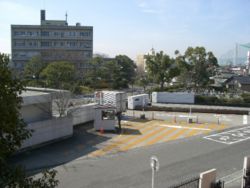Mie University: Difference between revisions
imported>John Stephenson m (delink) |
imported>Gareth Leng (→See also: delete for now) |
||
| Line 49: | Line 49: | ||
</div> | </div> | ||
[[Category: Education Workgroup]] | [[Category: Education Workgroup]] | ||
[[Category: CZ Live]] | [[Category: CZ Live]] | ||
Revision as of 17:21, 26 January 2008
| Mie University |
| 三重大学 ・ みえだいがく ・ Mie Daigaku |

|
| Entrance to Mie University in Tsu, Japan. |
| Undergraduate students: 6,238 (2002)[1] |
| Graduate students: 1,256 (2002) |
| Staff: 1,740 (2002) |
| President: Nagayasu Toyoda |
| Established: 31st May 1949 |
| Address: 1577 Kurimamachiya-chō, Tsu, |
| Mie 514-8507, Japan |
| 〒514-8507 三重県津市 |
| 栗真町屋町 1577 日本 |
| Telephone: +81 (0)59 231 9195 |
Mie University (三重大学 Mie Daigaku) is a higher education institution in Mie prefecture, Japan. As with other 'national' universities, 'Miedai' has been a national university corporation since April 2004, when state-funded universities were partially privatised.[2] In 2006, it was ranked 250th in the Times Higher Education Supplement list of the world's best universities.[3]
Mie University was founded on 31st May 1949 with two faculties: Liberal Arts and Agriculture. These gave way to the establishment's present composition of six faculties: Humanities, Medicine, Education, Bioresources, Engineering and Common Education - the latter dealing with cross-faculty courses such as English language teaching. Its 'Center for International Exchange' promotes international links and issues involving the global community.
The university is Mie's only higher education institution, located in the city of Tsu (津) in the Kansai region, within easy reach of Kyoto, Osaka and Nagoya. The campus is situated in the north-east of the city, close to the coast of Ise Bay. Though some students make use of nearby accommodation, larger numbers commute from the larger cities, as well as nearby towns such as Ise, Matsusaka and Toba.
Footnotes
- ↑ Mie University: 'Number of students and staff.'
- ↑ Mie University: 'Mie University History'.
- ↑ 'Mie University: 'Mie University ranked 250th internationally by the Times Higher Education Supplement'. 14th August 2007.